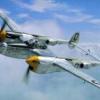Search the Community
Showing results for tags 'Lizzie'.
-
Lysander Twin Browning Machine Gun (648584) 1:48 Eduard Brassin Eduard have reboxed the 1:48 Lysander kit from Gavia a few times over the years, and one of those times has been a pretty recent affair. They usually include some goodies in the ProfiPACK box, but there’s always a little more in the way of detail the modeller can add. This set contains a twin Browning mount for the rear gunner, and as usual with Eduard's smallest Brassin sets, they arrive in a flat resealable package, with a white backing card protecting the contents and the instructions that are sandwiched between. This set contains eight resin parts on four casting blocks, plus a small fret of Photo-Etch (PE) for the finer details. The guns are moulded with a full-length cooling jacket, and mount on either side of a cruciform bracket, with ammo feeds curving up from below. Each barrel is fitted with two tiny PE parts near the muzzle, a central sight and an auxiliary sight on brackets mounted to the right barrel. A larger bracket is attached to the rear of the breeches and forms the top half of the twin grip mount, which are small resin spindles that slot into the depression in the lower arms of the mount and glue to the PE bracket at the top. The completed assembly is then a drop-in replacement for the kit gun, and you are given colour call-outs in Gunze codes throughout the build. Detail is up to Eduard’s usual exemplary standards, and preparation is simplified by the slim attachment points on each resin part, and you must remove the “bubble-catcher” prong moulded into the tip of each barrel before you finish. Highly recommended. Review sample courtesy of
-
The Westland Lysander – Airframe Detail #9 ISBN: 9781912932030 Valiant Wings Publishing Westland’s Lysander is a well-known and well-loved aircraft, having played an important part in the war, delivering and collecting British and foreign spies into occupied territory throughout WWII, usually at night and without escort. often the missions were successful, but they ran the risk of being intercepted by Night Fighters or landing in a compromised field that could result in death or capture for the crew as well as their passengers. Its design arose from a requirement for a cooperation and reconnaissance/spotter aircraft to replace an old biplane design by the name of Hector, and after a short competition the Westland design was chosen due to some happy coincidences and advanced features that were engineered into the airframe but might not have been well used in the other roles that the Lysander was originally required to carry out. Fortunately, the capabilities of the Westland design that gave it a 65mph stall-speed and a very short take-off and landing run won through and it entered service in 1938 just in time for war. Due to its low speed it was easy meat during daylight hours, and was quickly withdrawn from spotting duties after Dunkirk, but found other uses with the Special Operations "spooks". For self-defence the aircraft carried a machine gun (sometimes twin) in the rear position, and had the ability to carry two more in the roomy aerodynamic spats that covered much of the landing gear. It could also be fitted with a pair of winglets for small bombs or message dropping work, but the Mercury engine could only just manage a little over 200mph at height, so stealth was important over enemy lines, which necessitated night operations. It remained in service with the British until after WWII, and some were converted to Target Tugs, while others were used to assist in air sea rescue duties. The Mk.III was the last major variant from which additional sub-variants were created, including the twin rear guns, or an additional fuel tank between the landing gear for long-range operations. We'll ignore the Wendover beach-straffer experiment here, and if you haven't yet seen it, prepare yourself for a feast for the eyes. The Book This book, by prolific author Richard A Franks, with profiles and plans by Richard J Caruana and example model made by Libor Jekl is perfect-bound as usual and consists of 114 pages within a card jacket, printed on glossy paper stock throughout. It is number 9 in the Airframe Detail series that concentrates more on the aircraft in question, with just a short section to the rear with an example build of the very recent kit in 1:72 from Dora Wings models, which we reviewed recently here. The book is broken down into sections as follows: Introduction 1 Technical Description Detailed coverage of construction and equipment 2 Camouflage & Markings Colour side profiles, notes and photographs 3 Little Lizzie A build of the 1:72 scale Mk.III(SD) from Dora Wings by Libor Jekl Appendices i Lysander kits ii Lysander accessory & mask list iii Bibilography iv Lysander Squadrons Despite the Lizzie appearing to be somewhat outdated for the time with fixed gear and a greenhouse canopy, she was technically impressive with automated slats, slotted flaps, adjustable incidence elevators and some high-strength alloys used to reinforce the join between the landing gear, fuselage and wings. There are a number of extant airframes still, some of which are in flyable condition at home and abroad, so there are tons of photographs, diagrams and profiles, many contemporary in black and white, but many more in colour from preserved examples. The profiles are found in the 2nd section of the book, and show a number of profiles of various airframes along with photographic evidence and finished with a page of diagrams displaying the stencils and markings locations for the type. The sheer level of detail giving within the pages is perfect for the modeller, and will be of use to anyone from novice to super-detailer, with some of the photos and drawings showing the interior, subassembly layout, the instrument panel and other fine details that could improve your build, many of which I haven’t seen before, especially the repair and maintenance photos of the preserved airframes that should give anyone wishing to show off the interior excellent references. Libor Jekl's build of the new Dora Wings kit shows what can be done with the 1:72 model, and results in a lovely example that anyone would be pleased to have in their collection. From a modelling standpoint there is a little scope for building and painting one in 1:144 with the Fox One Design Studio kit in resin, and in plastic 1:72 from Dora, Airfix and Frog (there have been many reboxing of the Frog styrene), or in 1:48 from Gavia (Eduard reboxings are available) and in 1:32 we have the aging Matchbox/Revell kit. Conclusion Another Excellent volume from Valiant, and an interesting one as usual, showcasing this well-loved and under-appreciated aircraft that did much for the success of the Allies that is sadly difficult to quantify accurately, and some of its exploits remained unsung long after the war. Very highly recommended. Review sample courtesy of
-
As the BoB GB is now less than two weeks away I have decided to squeeze in a quick OOB build of the Matchbox Westland Lysander MkII as re-released by Revell as a 'Classic Kit' in 2008: It contains the Matchbox kit (though not moulded in two shades of brown as per the original) and the marking options are the same. The lack of 'bumps' on the cowling indicates this kit represents a Mk.II but the second option R9125 LXoL of 225 Squadron was a Mk.III. This doesn't affect me as I will be building L4805 UGoB of 16 Squadron operating in France in May 1940 which was indeed a Mk.II. The parts look pretty good, not noticeably worn and the famous Matchbox panel trenches don't look as bad as I had imagined they would; the 'fabric' effect is a little bit much, especially on the fuselage, but hopefully will be subdued a little by a coat of primer (or two): There is not a lot of detail in the cockpit but for 1973 this was considered quite well-appointed: To occupy a bit of space I will be adding the crew... I never particularly liked the Matchbox figures, they seemed a bit stiff and artificial looking compared to the contemporary standard Airfix 'crotch-fondler'... ... however I hope a little careful painting combined with the fairly thick canopy part will prove adequate. Speaking of the canopy, it has been dipped in Klear and my next job is to mask it... Cheers, Stew
- 158 replies
-
- 19
-

-
Hope this meets with the groups approval , I know am late to the party but hope to have it done in time if meets the group approval , love the old matchbox kits ;-)



